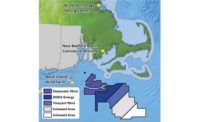
You could call it the Great Button Up.
Or the Big Batten Down.
Either way, contractors, owners and government agencies all along the Northeast U.S. coast secured jobsites in anticipation of Hurricane Irene making landfall over the Aug. 27-28 weekend.
As of Friday afternoon, Irene was classified as a Category 2 hurricane with maximum sustained winds of 100 mph.
For some, the preparations have lasted much longer than the storm will.
Scott Duckworth, vice president and division manager for Birmingham, Ala.-based Brasfield & Gorrie’s office in Raleigh, N.C., says his firm began deploying its hurricane emergency action plan (HEAP) on Aug. 23, a program that the firm asks its vendors and subcontractors to participate in.
The plan involves “securing, tying down or transporting to a safer location” anything on the jobsite that could be impacted by high waters and winds. He says his firm has two projects east of Wilmington, N.C.--an area that is considered at risk--but those projects are not at a stage where they are likely to be vulnerable to the storm.
Dave Buck, spokesman for the Maryland State Highway Administration, says the department has been preparing for Irene, also since Aug. 23. “We started to prepare for this hurricane around the time of the earthquake,” he says.
Crews at Maryland construction sites, including the 18-mile, $2.56-billion Intercounty Connector Project, are inspecting erosion and sediment controls and making any necessary repairs, he says. Moreover, crews are making sure cranes, signs, any materials are safely secured so that high winds don’t create additional hazards on the sites.
He adds that the Maryland State Highway Administration has a list of contractors it contacts in emergencies where there is flooding or other damage, just as it does during snowstorms to help with repairs and cleanup.
In Delaware, the $150-million Indian River Inlet Bridge project in Rehoboth Beach will put hurricane design and safety measures to the test.
The 2,600-ft-long cable-stay bridge is almost-fully cantilevered out over the water from either side of the 900-ft-wide inlet, but the spans have not been connected yet. The bridge design was wind-tunnel tested to withstand hurricane-force winds, according to a spokesperson for Skanska USA, the project’s design-build contractor.
Crews installed hurricane ties to secure the superstructure to piles driven into the ground, which will secure the bridge’s back span and main span, eliminating the "potential risk for excitement of the bridge due to high wind,” the spokesperson adds.
In New York City, Buildings Commissioner Robert LiMandri ordered all work at construction sites suspended from Saturday afternoon at 2 p.m. until Monday morning at 7 a.m.
Cranes, elevated work surfaces and elevators are a special concern.
DCM USA Erectors Inc. is taking down one of the booms of the two tower cranes atop One World Trade Center, as a precaution against the storm. A process that takes about four hours, it will assure that the booms don’t break free of their ties and collide under strong winds.
All other cranes are being secured at Ground Zero, just in case.
At Brooklyn-based All-Safe LLC, which rents its personnel hoists, including one being used for a massive renovation at Madison Square Garden in Manhattan, special precautions are being taken.
Equipment Manager Pat O’Sullivan had two workers check all doors and panels at the Garden site hoists. All-Safe also sent out email messages advising renters how they must leave the elevators when they are parked.
And that’s to not “leave it at the top of the tower,” says O’Sullivan.
In New England, which is more accustomed to winter storms, the Massachusetts Department of Transportation is securing all equipment. “Our engineers have been instructed to reschedule or cancel work as necessary to make sure sites are completely secured,” says a spokesman.
Similarly, the Massachusetts Bay Transportation Authority, says it has hurricane response plans in place at all of its construction sites including securing materials and equipment, lowering crane booms and standing by with pumps and crews. “We also have contractors on standby to assist anywhere we may need them,” says an authority spokesman.
Mark DiNapoli, president and general manager of the northeast region for Suffolk Construction, Boston says his firm began storm preparations on Aug. 23 and worked those into the normal work week without any delays.
Doubling Down and Fastened
Suffolk has asked project teams to double down and confirm that normal protocol is followed, including fastening down any construction material, he says. “We are lowering and fastening down crane masts and dropping all mechanical mast climbers and for some projects with significant exposures, we taken down exterior scaffolding,” he says.
“We are optimistic that the impact on our projects and schedules will be minimal, DiNapoli says. “In New England we are accustomed to severe weather.”
Cianbro Corp., a heavy construction and industrial contractor based in Pittsfield, Maine, began preparation by developing site-specific plans about where to store equipment, where to anchor barges and floats, and how to secure materials so they don’t blow around.
Cianbro is also securing office trailers, temporary construction buildings, barges, cranes and booms. ”We are planning for the worst and hoping for the best,” says Andy Vigue, president.
Although the wind event is expected to last less than 24 hours, Vigue says river levels could affect projects such as a $20-million pedestrian bridge project on the Potomac River’s towpath, in the Washington, D.C. area, that could be affected by the anticipated 6 inches of rain.
“The Potomac River could take days and weeks to return to its normal level,” he says, potentially causing multiple days of delay.
Some contracts allow for compensation for events like this while others do not, Vigue says.









